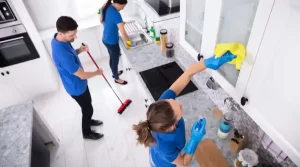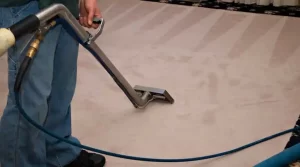Consider how much time you spend using electronic equipment like computers, keyboards and mice, copiers and printers, phones, and headsets. We use them often in our personal and business lives.
It is more important than ever to disinfect electronic equipment, especially considering the massive impact of COVID-19. This comprehensive guide, written by JP Salt Lake City Commercial Cleaning experts, will teach you all you need to know about cleaning and sanitizing electronic equipment safely and effectively.
What is the significance of cleaning and disinfecting electronic equipment?
Germs and diseases are abundant in electronic equipment. According to research, keyboards, mice, and other office equipment may be up to 10 times more filthy than a toilet seat! With all the time we spend on electronic gadgets, it’s no wonder many people become sick each year from preventable illnesses like the common cold and flu. Given the outbreak, cleaning is crucial. (1)
Cleaning and sanitizing electronic equipment is critical for two reasons: avoiding the spread of pathogenic microorganisms and safeguarding the gadget from damage. Dust, dirt, and grime may build up on electrical equipment over time, causing it to malfunction or fail. Cleaning and sanitizing your electronic equipment regularly may help to prolong its life and keep it working correctly.
What chemicals are safe for electronics?
Several cleaners and disinfectants on the market claim to be safe for electronics. However, not all of them are made equal. Some cleaners may damage electronic equipment, therefore, it is critical to pick one that is specifically designed for cleaning electronic equipment.
Isopropyl alcohol, popularly known as rubbing alcohol, is a popular and efficient electronic disinfectant.
(2) This disinfectant is safe on most electronic equipment and is especially effective at killing germs and bacteria. To get the best results, use an isopropyl alcohol disinfectant that includes at least 70% alcohol.
Hydrogen peroxide is another efficient and safe disinfectant for electronics. Because it is highly effective at killing germs and bacteria, this disinfectant is often used in hospitals and other medical environments. To obtain the highest effects, search for a hydrogen peroxide disinfectant with a concentration of at least 3%.
Steps to take before cleaning and disinfecting electronic equipment
- To get rid of dirt or germs, wash your hands thoroughly with soap and water.
- Disconnect all electrical gadgets from power outlets. When cleaning a computer, keyboard, or mouse, disconnect it from the computer and turn it off.
- Batteries in electrical devices should be removed. Because cleaning chemicals might be harmful to batteries, remove them before cleaning.
- Gather all necessary supplies, including disinfection wipes or spray, gloves, and a microfiber cloth.
- Check that the area where you’re working is well-ventilated.
- Remove the electrical equipment outside if feasible. This will help to keep dangerous chemicals and fumes from hurting the equipment.
- Tape any exposed electrical circuits or components. This will keep them safe while you clean and disinfect them.
How to disinfect and clean computer mice, keyboards, and monitors
- cleaning the monitor
- Wipe the monitor clean with a disinfectant wipe or spray a disinfectant into a microfiber cloth and wipe the screen clean. Keep any cleaner away from the bezel (the frame around the screen).
- Remove any cleaning from the bezel using a dry microfiber cloth.
- Using a glass cleaner and a clean, dry microfiber cloth, polish the screen.
Disinfecting keyboard:
- To remove any loose dirt or debris, shake the keyboard upside down.
- Wipe off the keys with a disinfectant wipe or a microfiber cloth doused with disinfectant. Make sure that you get between the keys.
- Remove any cleaning that has gotten on the keys with a clean, dry microfiber cloth.
- Use a glass cleaner and a clean, dry microfiber cloth to polish the keys.
- Removing the keys is only sometimes a brilliant idea. Removing the keys is straightforward if it’s secure and you want that extra level of cleanliness. Turn the keyboard upside down and shake it After cleaning them with a disinfectant wipe or spray and let them air dry, remove any loose dirt or debris by using a flathead screwdriver or a similar instrument to pry up the keys.
Disinfecting mouse:
- Wipe the mouse’s top with a disinfectant wipe or spray a disinfectant into a microfiber cloth and wipe it clean.
- Remove any dirt or debris between the buttons using a cotton swab or toothpick.
- Using a clean, dry microfiber cloth, remove any cleaning that has gotten on the mouse.
- Polishing the mouse using a glass cleaner and a clean, dry microfiber towel.
How to clean and disinfect copiers and printers
Disinfecting copier:
- Please turn off the copier and remove it from the power outlet.
- Remove any paper from the copier.
- Open all the doors and compartments on the copier to access all the surfaces that need to be cleaned.
Wipe down all surfaces with a disinfectant wipe or spray a disinfectant into a microfiber cloth and wipe it down. Wipe off the control panel, touch screen, buttons, and other areas where your hands come into touch.
- Remove any dirt or debris using a cotton swab or toothpick. From in between the keys or buttons.
- Using a clean, dry microfiber cloth, remove any cleaner that has gotten on the copier.
- Polish all surfaces using a glass cleaner and dry microfiber cloth.
- Reconnect the copier to the power outlet and restart it.
Disinfecting printer:
- Please turn off the printer and remove it from the power outlet.
- Remove any paper from the printer.
- Open all of the printer’s doors and compartments to access all surfaces that need cleaning.
- Wipe down all surfaces with a disinfectant wipe or spray a disinfectant into a microfiber cloth and wipe it down. Wipe off the control panel, touch screen, buttons, and other areas where your hands come into touch.
- To clean up any dirt or debris from between the keys or buttons, use a cotton swab or a toothpick.
- To get rid of any cleaner that could have called on the printer, use a dry microfiber cloth.
- Polish all surfaces using a glass cleaner and dry microfiber cloth.
- Restart the printer and reconnect it to the power supply.
How to clean and disinfect phones and headsets
Disinfecting phones:
- Turn off your phone.
- Remove the battery (if feasible) and SIM card.
- Wipe down all surfaces with a disinfectant wipe or spray a disinfectant into a microfiber cloth and wipe it down. Wipe the screen, buttons, and other surfaces that come into contact with your hands.
- To clean up any dirt or debris from between the keys or buttons, use a cotton swab or a toothpick.
- Using a clean, dry microfiber cloth, wipe away any cleaner that has gotten on the phone.
- Polish all surfaces using a glass cleaner and dry microfiber cloth.
- Replace the battery (if feasible) and switch on the phone.
Disinfecting headsets:
- Turn off your phone.
- Remove the battery (if feasible) and SIM card.
- Wipe down all surfaces with a disinfectant wipe or spray a disinfectant into a microfiber cloth and wipe it down. Wipe the screen, buttons, and other surfaces that come into contact with your hands.
- To clean, use a cotton swab or a toothpick. Remove any dirt or debris from between the buttons or keys.
- Wipe off any cleaner that has gotten on the phone with a clean, dry microfiber cloth.
- Using a glass cleaner and a dry microfiber cloth, polish all surfaces.
- Replace the battery (if possible) and turn the phone on.
- How to clean and disinfect a laptop
Disinfecting the exterior:
- Wipe the monitor clean with a disinfectant wipe or spray a disinfectant into a microfiber cloth and wipe the screen clean. Keep any cleaner away from the bezel (the frame around the screen).
- Wipe the keyboard down with a disinfectant wipe or a disinfectant sprayed onto a microfiber cloth. Take caution not to step between the keys.
- Wipe the touchpad with a disinfectant wipe or spray a disinfectant onto a microfiber cloth and clean it.
- Using a clean, dry microfiber cloth, remove any cleanser that has gotten on the display, keyboard, or touchpad.
- Using a glass cleaner and a clean, dry microfiber cloth, polish the screen.
- Polish the keyboard using a glass cleaner and a dry microfiber towel.
Cleaning the interior:
- Blow any dust or dirt out from between the keys using compressed air.
- Wipe down the keyboard with a disinfectant wipe or spray a disinfectant onto a microfiber cloth. Make careful to go between the keys.
- Wipe down the touchpad with a disinfectant wipe or spray a disinfectant into a microfiber cloth and wipe it down.
- Clean any dirt or debris between the buttons using a cotton swab or toothpick.
- Remove any cleaner that may have gotten on the keyboard or touchpad using a clean, dry microfiber cloth.
- Polish the keyboard using a glass cleaner and dry microfiber cloth.
Is UV valuable light for disinfecting electronic devices?
UV light disinfection is a popular method for disinfecting electronic gadgets. However, there is no scientific evidence that UV radiation disinfection effectively kills germs and bacteria. Multiple studies have shown that UV radiation may destroy electrical devices. (3)
If you use UV light disinfection, ensure you do it properly. First, unplug the gadget from any power source. Place the UV light at least six inches away from the device. Please turn on the UV light and let it disinfect the equipment for at least two minutes. After disinfection, ensure the equipment is completely dry before using or storing it.
What not to do when cleaning and disinfecting electronic equipment
When cleaning and sanitizing electronic equipment, you should avoid a few things.
- Use no cleaners or disinfectants that have not been specifically designed to clean electronic equipment. These cleaners may cause severe damage to the equipment.
- Do not immerse electrical gadgets in liquids. This might damage the devices and void any warranties.
- Using UV light, disinfect any electronic equipment with sensitive surfaces, such as LCD screens. UV radiation may damage certain surfaces.
- Avoid putting harsh chemicals on electrical equipment, such as bleach. These compounds have the potential to damage electronics.
- Do not clean electrical equipment using compressed air. The compressed air may push dirt and particles into the device, causing it to malfunction.
How often should electronic equipment be disinfected?
It is essential to disinfect electronic equipment regularly, mainly if many people use it. However, if you use electronic equipment at a hospital or someone sick has used it, you should clean it more often.
If someone who uses the equipment becomes unwell, disinfect it as quickly as feasible. If the equipment comes into contact with bodily fluids like blood or saliva, it should also be cleaned.
What are the advantages of cleaning and sanitizing electronic equipment regularly?
Cleaning and sanitizing electronic equipment regularly helps prevent the spread of illness in the workplace. Cleaning the equipment might reduce the number of sick days used by employees. This may help boost workplace productivity and morale.
It also extends the life of your electrical gadgets. You may help prevent filth and dust accumulation on the equipment by sanitizing it regularly. Follow these methods to properly clean and disinfect your electronic equipment.
Do you need professional assistance?
JP Salt Lake City Commercial Cleaning is an expert at cleaning commercial spaces and equipment, even the most sensitive ones. It is more important than ever that both workers and customers feel safe and that disinfection is a top priority. Remove the burden of cleaning yourself or worrying whether your company is clean. Contact the JP Salt Lake City Commercial Cleaning staff at 867 1st Ave for personalized service plans. N. Salt Lake City, UT.







